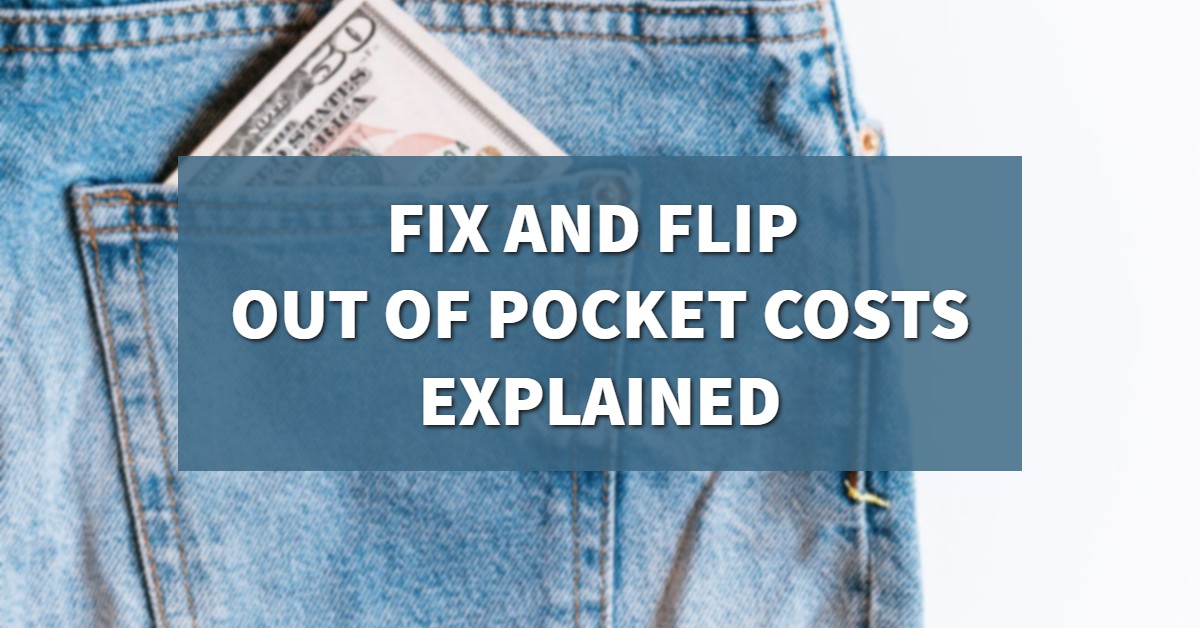How much in out of pocket costs should you expect for your fix and flip?
For every fix and flip or investment property you buy, money is going to come from two places: lenders and your own pocket.
We know lenders can lend up to 90% to 85% of the purchase and 100% of the rehab. But even with these big numbers, it’s important to know what out of pocket costs you’re on the hook for as a real estate investor.
What Does “Lender Funding” Actually Mean?
When lenders talk about funding 90% of purchase or 100% of a renovation, it sounds like they’re paying for more than they actually are.
True, they’re taking care of a huge portion of the cost (that you will pay back eventually), but you’re still going to encounter additional costs and fees that you’ll have to pay out of pocket.
We’re here to explain these costs so you’re ready for them. If you’re not prepared, it stalls your project, and you might end up paying even more than you otherwise would have.
So What Are Your Out of Your Pocket Costs?
1. Initial Deposit and Closing Costs
When you sign the contract, you’ll need to put down an initial deposit. This is part of what you see in a HUD-1 settlement.
Additionally, if a lender lends 90% of the purchase price and a 100% of the rehab costs, it looks like all you have to bring in is the remaining 10% of the purchase price.
However, you should also be prepared for additional closing costs and fees. Lenders will not cover those, and you’ll need to pay out of pocket.
2. Out of Pocket Lender Costs
Lenders also have additional fees. They often charge between 1% to 2.5% of the loan amount for appraisals, credit underwriting, and other services
For example, if the total purchase cost of a property is $200,000, and a lender covers 90% of that cost, you can expect to cover the remaining 10% ($20,000). Additionally, lender fees can quickly add an extra $2,800 to $5,600 that we owe to the lender as an out of pocket cost.
3. Title Costs
On top of that, we have title costs. Title costs are typically 0.5%f to 1% of the purchase price.
Using the same example, if you have a purchase price of $200,000, title charges will likely be an additional $1,000 to $2,000 in out of pocket costs.
4. Mortgage Tax (In Some States)
Check your area to find out about your mortgage tax rates. You won’t have to worry about this in every state, but do your research so you’re prepared.
5. Insurance Costs
Insurance often costs somewhere between $1,000 to $2,000 and needs to be paid out of pocket upfront.
6. Out of Pocket Monthly Interest
Interest rates depend on your particular loan. To add to our earlier example ($200,000 purchase price, covered 90% and $100,000 rehab price, covered 100%), let’s say your interest rate is 12% (1% a month).
If you have a loan for $280,000 and they’re charging you interest on the full amount, you could expect a payment of $2,800 every month. If you have it for four months, that’s $11,200 out of your pocket.
Essentially, after we add up all of these expenses, you can expect to pay a fair amount of additional out of pocket costs that the lender won’t cover. You should also look out for HOA fees or overages that will also have to come out of your own pocket.
Reimbursable Out of Pocket Costs
You should also have extra funds in your money bucket to pay for certain projects up front.
Most lenders only reimburse you for completed work, and you’ll need out of pocket money to fund the first one or two draws to keep the project going.
These can be expensive and could cost around $15,000 each. You can find more information about how to pay for these first draws in this article from Hard Money Mike.
These draws will be reimbursed eventually, but you need the funds available up front to get the project moving. This isn’t technically an out of pocket expense, but it can feel like it while you’re waiting for those first projects to be completed.
How to Fund Out of Pocket Costs
It can be overwhelming to look at the out of pocket costs adding up. You can easily expect to pay an additional $20,000 in expenses alone, and that number can rise to $50,000 if you include the funding you’ll need for draws.
It’s best to have these funds available in a savings account, but you can also use gap financing.
It’s also important to build your credit and be smart about how you’re using credit cards. Some business credit cards let you draw beyond the cash limits. This can be helpful in covering some out of pocket expenses.
You can also look into hard money loans. Depending on your project, different loan options can be a better fit. Shop around on the front end to make sure your projects won’t be delayed. You can also use our loan cost optimizer to help you find the right deal for you.
If you have a deal you’d like us to price out, we’d be glad to help. Just reach out to us at Info@TheCashFlowCompany.com.
If you want more information about real estate investing in general, check out our YouTube channel.

